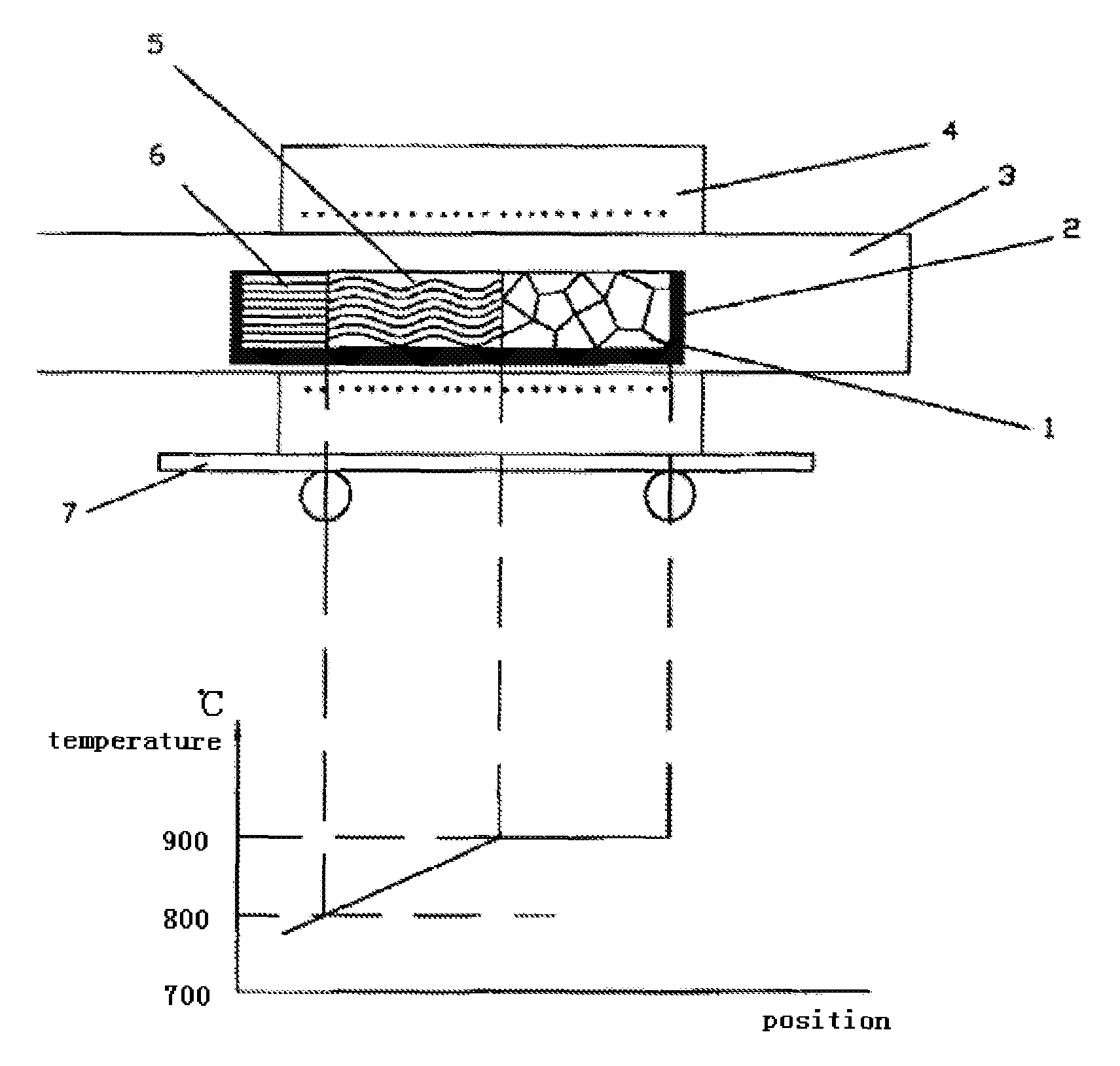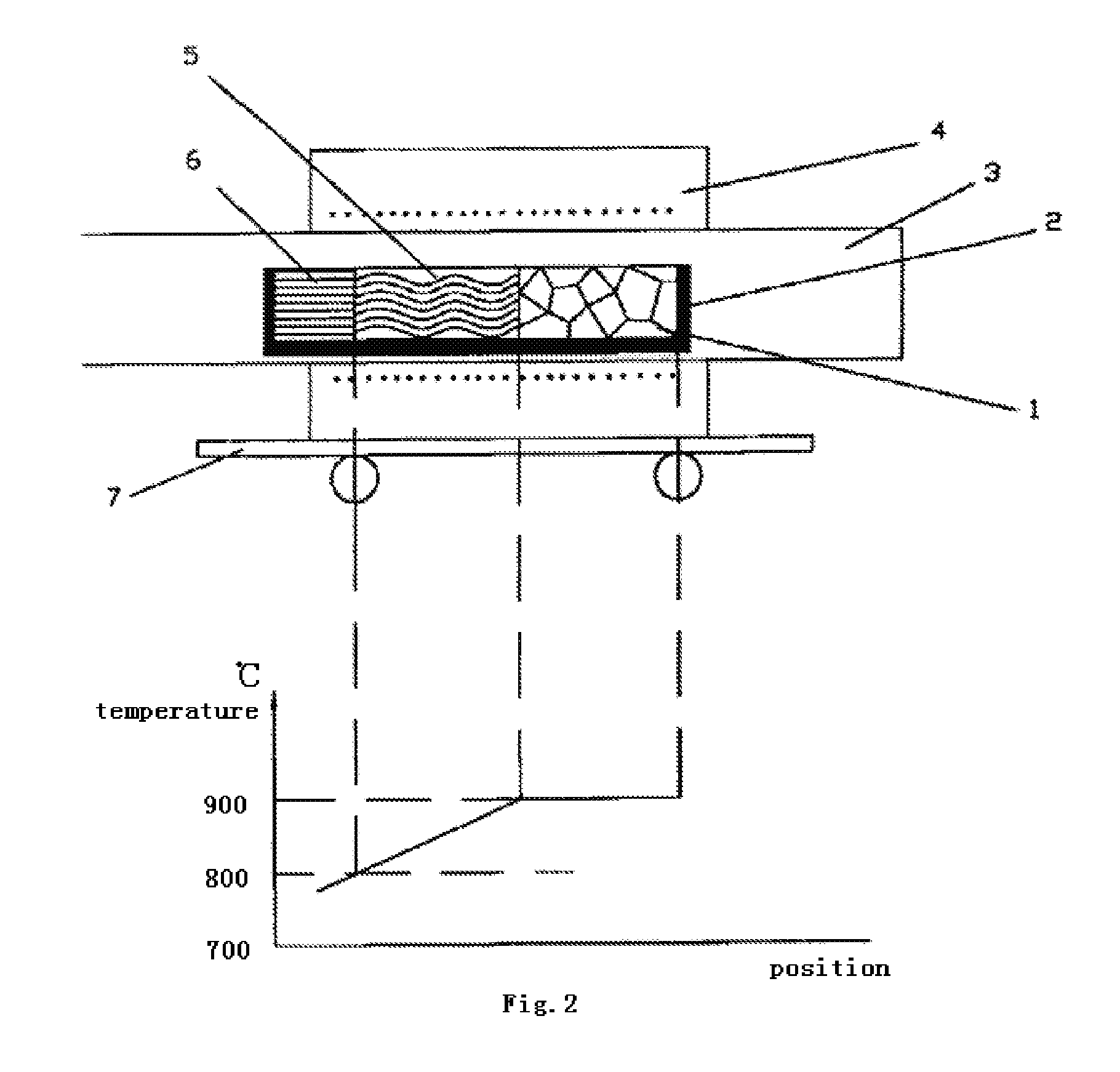Method for purifying silicon
a technology of purification method and silicon, applied in the direction of crystal growth process, polycrystalline material growth, silicon compound, etc., can solve the problems of insufficient photoelectric conversion efficiency, high photoelectric conversion efficiency, and defects of solar cells, so as to reduce the contents, reduce the effect of harmful impurities and effectively remove harmful impurities
- Summary
- Abstract
- Description
- Claims
- Application Information
AI Technical Summary
Benefits of technology
Problems solved by technology
Method used
Image
Examples
example 1
[0043]The spread process of the silicon solute and the temperature distribution of the heating furnace are illustrated in the schematic diagram of FIG. 2. The steps for purifying silicon are as follows:
[0044](1) Mix aluminum with the purity 4N or 5N with silicon with the purity 4N or 5N in proportion as silicon accounts for 26% of total aluminum by weight and melting the aluminum-silicon mixture in the graphite boat 2 under air pressure of 10−2 Pa. The quartz tube 3 is taken out of the heating furnace 4 immediately after the components are uniformly mixed. The square shaped aluminum-silicon alloy ingot is obtained upon the cooling down of the materials. The aluminum-silicon alloy ingot is taken out after being cooled down to room temperature. The surface thereof is polished, rinsed and dried for later use. Besides, the high-purity silicon with the purity 4N or 5N is also prepared for later use by cleaning and drying its surface.
[0045](2) Weigh silicon with the purity 4N or 5N in the...
example 2
[0050](1) Prepare aluminum with the purity 4N or 5N and silicon with the purity 4N or 5N according to a ratio by weight of aluminum:silicon=74% :146% and place both of them in the graphite boat 2 at the same time, wherein aluminum is on the left side and silicon is on the right side.
[0051](2) Close the quartz tube 3 and starting the vacuum system. Start to heat when air pressure is lower than 10−2 Pa. The heating furnace 4 controls the graphite boat 2 to be completely within 800° C. range and maintains the temperature constant. When the dissolving concentration of silicon in aluminum becomes even, adjust the heating furnace to make the left side of the graphite boat maintain 800° C. and increase the temperature of right side in the meantime. When the temperature of the solid-liquid interface between the undissolved silicon on the right side and the aluminum-silicon melt reaches 900° C., the solute silicon starts to spread from right to left till the left side of the graphite boat an...
example 3
[0053]Conduct according to the device illustrated in FIG. 2. The steps included are as follows:
[0054](1) Prepare aluminum with the purity 4N or 5N and silicon with the purity 4N or 5N for the aluminum-silicon alloy containing ≧38% by weight of silicon and place them in the high-purity graphite boat 2. Heat them to melt under the atmosphere of the air pressure being lower than 10−2 Pa. Remove the quartz tube 3 out of the heating furnace 4 when the ingredients become even. The aluminum-silicon alloy ingot containing ≧38% of silicon with a square-shaped section is obtained after the materials cool down. Dry for later use after the surface thereof is polished and cleaned.
[0055](2) The silicon seed crystals with a square-shaped section which match the inner wall of the graphite boat are placed at the position 6 on the left side of the high-purity graphite boat 2 where pure silicon is segregated, the aluminum-silicon alloy ingot prepared in the above mentioned steps is placed at the posit...
PUM
 Login to View More
Login to View More Abstract
Description
Claims
Application Information
 Login to View More
Login to View More - R&D
- Intellectual Property
- Life Sciences
- Materials
- Tech Scout
- Unparalleled Data Quality
- Higher Quality Content
- 60% Fewer Hallucinations
Browse by: Latest US Patents, China's latest patents, Technical Efficacy Thesaurus, Application Domain, Technology Topic, Popular Technical Reports.
© 2025 PatSnap. All rights reserved.Legal|Privacy policy|Modern Slavery Act Transparency Statement|Sitemap|About US| Contact US: help@patsnap.com



